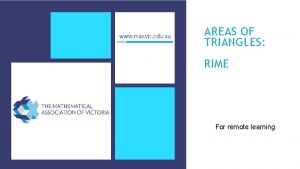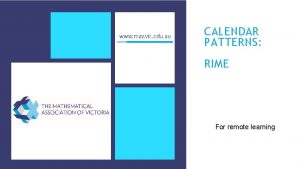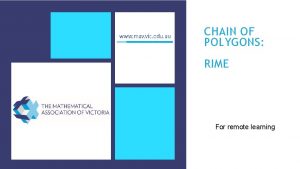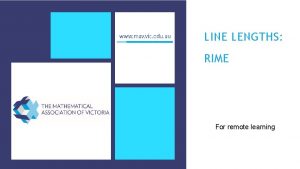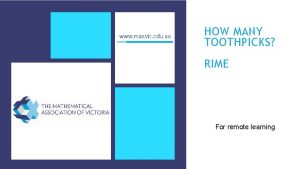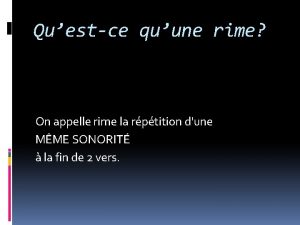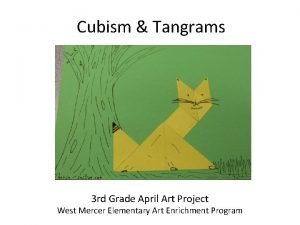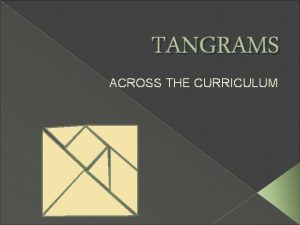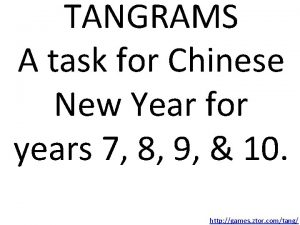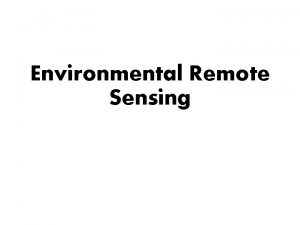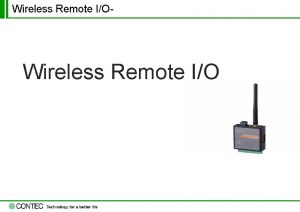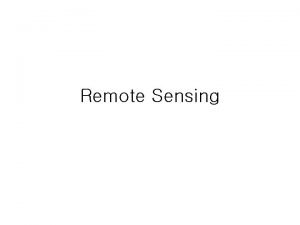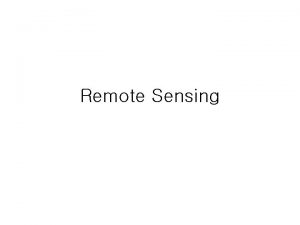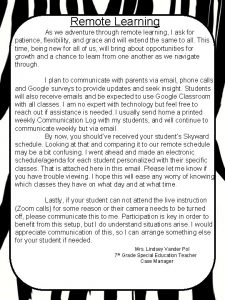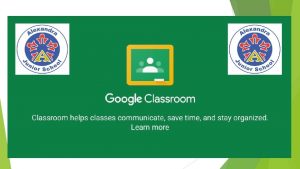TANGRAMS RIME For remote learning RIME TANGRAMS Key





















- Slides: 21

TANGRAMS: RIME For remote learning

RIME : TANGRAMS Key premise: In this task, students will TEACHER GUIDE: TASK OVERVIEW Use tangrams pieces to create and explore the properties of shapes. Task requirements: Students will be required to Complete tangram challenges. Identify the similarities and differences between common shapes. Key skills, strategies and understandings: Students will be able to Identify the properties of quadrilaterals and other shapes Know how areas of smaller shapes can be combined to form larger shapes.

TEACHER GUIDE: REMOTE LEARNING CHALLENGES AND STRATEGIES An excellent set of problems for examining orientation of shapes, types of polygons and working systematically. This task seeks to develop students’ abilities to perceive geometrical relationships while at the same time improving their knowledge of shape names and properties. It is preferable that students have physical tangrams that they use (e. g. printed shapes that are cut out). Otherwise, they should use interactive tangrams. Asynchronous delivery Students collaborate and communicate with each other Buddy students up to work together via email or across communication platforms. Use chat features in Webex for students to work together. Use online platforms for students to collaborate on journaling – e. g. Google Docs, One. Note. Student feed back their understanding to the teacher Use online tools such as Google Forms – students submit answers to questions in their own time. Use of school LMS systems – submission of ideas. Use Google Docs or One. Note strategy mentioned above – teacher will be able to see what students are doing in real time and provide feedback. Students document their work If using offline hard copy journals, students can take photos and send these to the teacher. Students submit their work for teacher feedback Students submit their completed journal through either email or a communication platform.

TEACHER GUIDE: REMOTE LEARNING CHALLENGES AND STRATEGIES For this task, students are encouraged to collaborate by: sharing results in pairs or groups of four via virtual communication e. g. Webex documenting their work using diagrams and taking photos of what they have created. indicating their understanding by recording reflections. submitting their findings, any photos and their reflections to the teacher.

TEACHER GUIDE: LINKS TO THE CURRICULUM Key learning outcomes: § Identify the properties of quadrilaterals and other shapes § Know how areas of smaller shapes can be combined to form larger shapes. What would be some common misconceptions or difficulties that teachers need to keep an eye out for? § Students may find it difficult to proceed through the problems in order. It is okay if they tackle the problems in the order that makes sense to them. This may help with drawing connections. § Students may require support in understanding what certain shapes could look like, e. g. trapezium and parallelogram in the first set of problems, and hexagon in the second set (NB: it will be an irregular hexagon). Go through the definitions of these shapes with students; show them examples and non-examples. Curriculum strand(s) Measurement & Geometry Curriculum substrand(s) Geometric reasoning, Using units of measurement Level addressed 8 Establish properties of quadrilaterals using congruent triangles and angle properties, and solve related numerical problems using reasoning (VCMMG 293) Find perimeters and areas of parallelograms, trapeziums, rhombuses and kites (VCMMG 287)

TEACHER GUIDE: ANSWERS 1. 2. 3. 4. 5. 6. 7. 8. 9. 10. 11. 12. 13. 14. 15. 16. 17. 18. 19. 20. 21.

STUDENT SLIDE 1: TANGRAMS The problem: Tangrams are made up of just 7 shapes, yet the possibilities for what you can make using these shapes are enormous. This task will challenge you to think creatively and strategically! Learning intentions Know how to use shapes to make other shapes. Know how different shapes are similar and different. Success criteria Complete tangram challenges. Identify the similarities and differences between shapes. Equipment needed Paper Pen/Pencil Tangram shapes to cut out and scissors OR Online tangrams (click here)

STUDENT SLIDE 2: TANGRAMS What do you notice about the image on the left? What do you wonder?

STUDENT SLIDE 3: TANGRAMS These seven shapes in a square tangrams. Tangrams are hundreds of years old and come from China. They became popular throughout the world at the start of the 19 th century. There have been thousands of puzzles and books written about them.

STUDENT SLIDE 4: TANGRAMS What shapes can you see in these tangrams? Can you see shapes made of more than one other shape? Discuss what you notice with a classmate.

STUDENT SLIDE 5: TANGRAMS Here are some of the shapes you may have noticed. . .

STUDENT SLIDE 6: TANGRAMS Triangles A three-sided shape, whose three angles add to 180 o.

STUDENT SLIDE 7: TANGRAMS Squares A shape with four equal sides and four equal angles that are 90 o.

STUDENT SLIDE 8: TANGRAMS A parallelogram A four-sided shape with two pairs of parallel sides.

STUDENT SLIDE 9: TANGRAMS A trapezium A four-sided shape with one pair of parallel sides.

STUDENT SLIDE 10: TANGRAMS B D Using the tangram pieces, can you find these other shapes? Draw the shapes you make. 1. DEF triangle 2. DEF 7. CDEG parallelogram rectangle F A E G 6. DEC trapezium C 3. DEF rectangle 8. CDEG parallelogram 4. DEF trapezium 9. CDEG 5. DEG rectangle trapezium

STUDENT SLIDE 11: TANGRAMS B D Ready for the next level of challenge? ! F A E G C

STUDENT SLIDE 12: TANGRAMS Using the tangram pieces, create and then draw these shapes: B D 10. CDEFG square 16. All rectangle 11. CDEFG rectangle 17. All trapezium F A 12. CDEFG trapezium 18. All triangle 13. CDEFG parallelogram E G C 14. CDEFG right triangle 15. CDEFG hexagon 19. All parallelogram 20. All hexagon 21. All pentagon

REFLECTION What tips would you give someone else who is doing this task? How are a square and rectangle the same? How are they different? How are a rectangle and parallelogram the same? How are they different?

EXTENSION All squares are rectangles, but not all rectangles are squares. We can show the relationship between squares and rectangles like this: Rectangles Squares

EXTENSION This diagram can show the relationship between even more types of shapes: § Rectangles § Squares § Trapezia § Rhombi § Parallelograms Can you work out where each shape goes? ? ?
 Cuadro comparativo e-learning b-learning m-learning
Cuadro comparativo e-learning b-learning m-learning Key partners canvas
Key partners canvas Contoh bisnis model canvas makanan pdf
Contoh bisnis model canvas makanan pdf Iso 22301 utbildning
Iso 22301 utbildning Novell typiska drag
Novell typiska drag Nationell inriktning för artificiell intelligens
Nationell inriktning för artificiell intelligens Vad står k.r.å.k.a.n för
Vad står k.r.å.k.a.n för Shingelfrisyren
Shingelfrisyren En lathund för arbete med kontinuitetshantering
En lathund för arbete med kontinuitetshantering Särskild löneskatt för pensionskostnader
Särskild löneskatt för pensionskostnader Tidbok
Tidbok Anatomi organ reproduksi
Anatomi organ reproduksi Densitet vatten
Densitet vatten Datorkunskap för nybörjare
Datorkunskap för nybörjare Stig kerman
Stig kerman Hur skriver man en debattartikel
Hur skriver man en debattartikel Magnetsjukhus
Magnetsjukhus Nyckelkompetenser för livslångt lärande
Nyckelkompetenser för livslångt lärande Påbyggnader för flakfordon
Påbyggnader för flakfordon Tryck formel
Tryck formel Publik sektor
Publik sektor Lyckans minut erik lindorm analys
Lyckans minut erik lindorm analys























